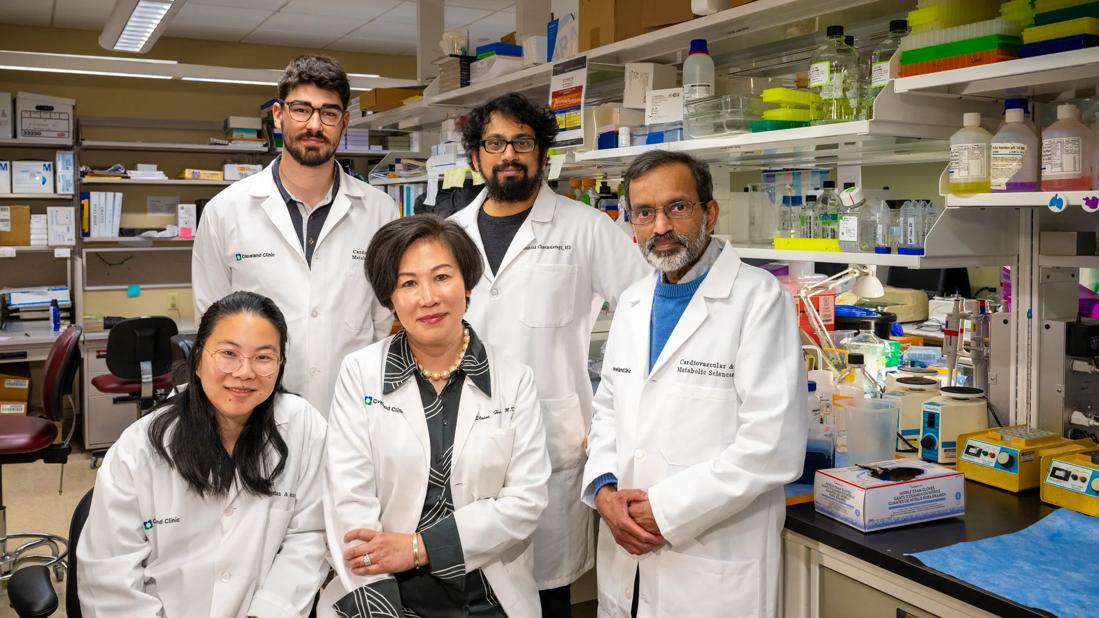Translational human plasma studies

By M. Elaine Husni, MD, MPH, and Unni Chandrasekharan, PhD
Advertisement
Cleveland Clinic is a non-profit academic medical center. Advertising on our site helps support our mission. We do not endorse non-Cleveland Clinic products or services. Policy
Numerous studies have reported increased cardiovascular (CV) morbidity and mortality in rheumatoid arthritis (RA) and psoriatic arthritis (PsA) patients that traditional risk factors cannot explain. Some have hypothesized that this increased risk is in part due to persistent systemic inflammation; chronic inflammation promotes endothelial dysfunction with reduced vascular reactivity, leading to CV disease (CVD).
L-arginine metabolism is critical for maintaining normal endothelial homeostasis, and arginases are the central enzymes in the urea cycle that catalyze L-arginine to L-ornithine and urea. Our translational research lab’s goal is to identify specific pathways leading to aberrant L-arginine metabolism as a potential cause of the increased CVD risk observed in RA and PsA patients.
L-arginine is the sole source of nitric oxide (NO), an enhancer of endothelial function as well as modulator of insulin sensitivity, whose production is catalyzed by NO synthases (NOS). Elevated arginase activity diminishes L-arginine bioavailability, thus decreasing NO production. Decreased NO has been associated with endothelial dysfunction, one of the earliest steps in atherosclerosis. Furthermore, elevated arginase activity causes excessive production of ornithine, leading to vascular dysfunction. The current study aimed to understand these underlying molecular mechanisms by using human plasma to analyze L-arginine metabolites in PsA and RA.
We used liquid chromatography-mass spectrometry approach to measure plasma levels of L-arginine, L-ornithine (arginase catabolic product) and L-citrulline (NOS catabolic product) in the plasma of RA and PsA patients compared with control subjects. We also measured methylated L-arginine products asymmetric dimethyl arginine (ADMA) and symmetric dimethyl arginine (SDMA), both endogenous inhibitors of NO production.
Advertisement
Furthermore, we measured plasma arginase activity using colorimetric assay. We analyzed correlations between L-arginine metabolites and CV risk factors using spearman correlation.
Plasma arginase activity levels increased 400 percent in RA patients (N = 119) and 160 percent in PsA patients (N = 233) as compared with controls (N = 148). Also, RA patients with prior CVD history had higher arginase activity compared with RA patients without prior CVD.
Compared with controls, the RA patients showed significantly lower levels of plasma L-arginine and elevated levels of ADMA and SDMA. Arginase activity and its catabolic product L-ornithine were elevated in RA, while the level of NOS catabolic product, L-citrulline was diminished. In comparison with controls, PsA patients also showed lower levels of plasma L-arginine, higher arginase activity and elevated levels of plasma ADMA and SDMA.
This work in human plasma builds upon our prior work that found altered L-arginine metabolism in murine models. Our study has the potential to link increased arginase activity and elevated levels of dimethylarginines to the premature vascular dysfunction disproportionally seen in RA and PsA patients. Thus, inhibition of arginase activity and blockade of pathways that generate methylated arginine derivatives have the potential to decrease CV risk in these patients. These elevated arginine metabolites in RA and PsA patients suggest an important avenue for detecting subclinical endothelial dysfunction.
Translational work combining these human plasma studies with our previous mouse model data will enable our team to identify new, precise biomarkers and potential treatment pathways that may help pinpoint and treat RA and PsA patients at increased risk of CV disease.
Advertisement
Dr. Husni is Director of the Arthritis and Musculoskeletal Treatment Center and Endowed Chair of Translational Functional Medicine Research at Cleveland Clinic.
Dr. Chandrasekharan is a researcher in the Department of Cellular and Molecular Medicine at the Learner Research Institute.
Advertisement
Advertisement

Unraveling the TNFA receptor 2/dendritic cell axis

Husni Lab focuses on transforming management and treatment

E-coaching program is tailored for those with the disease

Sustained efficacy and safety

Evaluating PROs in immune-mediated diseases

A practical PRO biomarker databank

Distinguishing the cause of fevers in patients with lupus

Relationship in patients treated with pegloticase